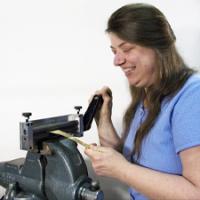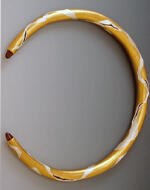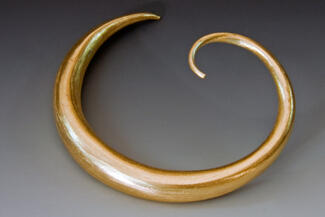Spiculums: Three Ways in Three Days
The elegant, tapered, hollow forms known as spiculums hold a unique fascination for jewelers and metalsmiths. Spiculums make efficient use of precious metals, since they are hollow and formed from thin metal sheet. Light yet strong, spiculums are used in jewelry, hollowware, and sculpture.
There are three basic methods and types of spiculums: "straight spiculums" are formed as a straight tapered tube, and soldered if the spiculum is going to be bent. "Open seam" spiculums are anticlasted and formed into a tube at the same time. The hammering is done along the outside of the form, putting the seam along the outer surface, which is usually left un-soldered, or "open". Synclasted spiculums have the seam on the inside of the curve. The seam may be left open, or it can be soldered if tighter curves are desired.
In this three-day workshop, all three types of spiculum will be demonstrated, followed by work time for students to practice each form. Participants must be comfortable using the typical tools of a jeweler: torch, files, and jeweler's saw. Experience with hammering and forming is helpful, but not required. Students will be taught how to hammer comfortably and efficiently.
Cynthia Eid has been hammering and forming metal for over 40 years. She co-authored the book, Creative Metal Forming, with Betty Helen Longhi, published by Tim McCreight's Brynmorgen Press with a foreword by Michael Good. If you'd like to see more of Cynthia's work, please visit her website www.cynthiaeid.com
Meet the instructor

Whether using hammers and stakes, or hydraulic press tools, Cynthia's sculptural jewelry and hollowware shows her focus on exploring the fluidity with which metal can be moved, formed, and joined.
Cynthia Eid co-authored the book Creative Metal Forming, with Betty Helen Longhi, published in 2013 by Tim McCreight's Brynmorgen Press. In his foreword for the book, Michael Good says the authors "have succeeded in assembling the first comprehensive textbook on synclastic and anticlastic forming." (More about the book available at www.creativemetalforming.com.)
Cynthia and Betty developed a set of anticlastic stakes, and Eid also works with Knew Concepts and Bonny Doon to help make tools for jewelers and metalsmiths. Lee Marshall has dubbed Cynthia Eid "Godmother of the Knew Concept Saws" since it was her idea for him to produce these saws for jewelers.
Excited about working in sterling silver without the problem of firescale, Cynthia has been working with Argentium Silver since 1999. After meeting Peter Johns (the inventor of Argentium Silver) in 2003, Eid has participated in AS's development. Argentium International, Ltd recognizes her as a Pioneer.
Cynthia Eid's metalwork has won awards for creativity and design, been featured in many publications, and been exhibited internationally. With a BS in Art Education and MFA in Jewelry, Design, and Silversmithing, she has previously worked as a bench jeweler for fine goldsmiths, a model-maker in a gold jewelry factory, and on private commissions. Her work is in museums in the US and UK. Currently an independent metalsmith and educator, she teaches weekly classes at Metalwerx in Massachusetts, and workshops and short courses in the US, Canada, Europe, and Australia.
Materials & Tools
There is a $35 materials fee for this course, which is payable upon registration. This fee pays for 24 gauge NuGold sheet, wood to make into forming blocks as well as tool maintenance. If students decide to purchase the tools use in the workshop from Cynthia Eid, they will receive a discount in the amount of the tools maintenance portion of the materials fee.
A tool kit for each student will be provided by the instructor. On the last day of the workshop, students may choose to purchase any tools from the kit that they wish to own. You are welcome to bring your own hammers and stakes with you if you would like, either to use in the workshop, or to compare to other tools that you may wish to purchase. You may also bring photos of your tools for comparison.
- Additional metal if desired:
- Enough NuGold will be provided for students to make 3 sample spiculums; one in each style taught. If students would like to have the option to make more, they can bring more metal to work with.
- All metal should be 24 gauge
- NUGold, copper, Argentium sterling, fine silver, and traditional sterling silver are all apropriate for this technique.
- Enough NuGold will be provided for students to make 3 sample spiculums; one in each style taught. If students would like to have the option to make more, they can bring more metal to work with.
- Hammers and Stakes
- Metalwerx has hammers and stakes, and the instructor will also have hammers and stakes for use during the workshop, and for sale. However, students are encouraged to bring tools if they have them. If you are flying, you can check the tools in a suitcase, or mail them to Metalwerx. (If you bring what you have, it will be easier for the instructor to advise you whether your tools will work, or need to be adjusted--which we can help with--or if you need a different tool.)
- Hammers and stakes will be available for purchase.
- Hand Tools: Metalwerx has plenty of hand tools for students to use, but you may wish to bring your own favorites:
- Hand-held shears, such as Joyce Chen
- Jeweler's saw and saw blades
- Pliers, especially if you have flat/round or half-round/flat with the flat jaw being plastic
- File(s) such as a #2 half-round file (full size, not a needle file) #4 is nice to have, too.
- Sanding sticks, abrasive papers
- Scissors, ruler, paper, pencil, fine-tipped permanent marker (e.g. Sharpie)
- Closed-toed footwear should be worn in the studio for safety (hot, sharp and/or heavy things tend to be dropped onto toes)
- Long hair needs rubber bands or barrettes to keep it away from flames and machinery.



